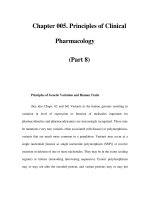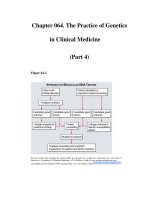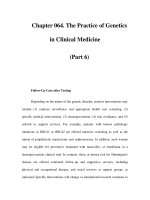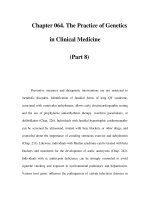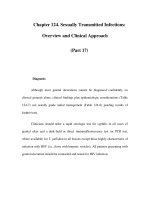Chapter 124. Sexually Transmitted Infections: Overview and Clinical Approach (Part 15) pot
Bạn đang xem bản rút gọn của tài liệu. Xem và tải ngay bản đầy đủ của tài liệu tại đây (14.51 KB, 5 trang )
Chapter 124. Sexually Transmitted Infections:
Overview and Clinical Approach
(Part 15)
Pelvic Inflammatory Disease: Treatment
The 2006 CDC guidelines recommend initiation of empirical treatment for
PID in sexually active young women and other women at risk for PID if they are
experiencing pelvic or lower abdominal pain, if no other cause for the pain can be
identified, and if pelvic examination reveals one or more of the following criteria
for PID: cervical motion tenderness, uterine tenderness, or adnexal tenderness.
Women with suspected PID can be treated as either outpatients or
inpatients. In the multicenter Pelvic Inflammatory Disease Evaluation and Clinical
Health (PEACH) trial, 831 women with mild to moderately severe symptoms and
signs of PID were randomized to receive either inpatient treatment with IV
cefoxitin and doxycycline or outpatient treatment with a single IM dose of
cefoxitin plus oral doxycycline. Short-term clinical and microbiologic outcomes
and long-term outcomes were equivalent in the two groups. Nonetheless,
hospitalization should be considered when (1) the diagnosis is uncertain and
surgical emergencies such as appendicitis and ectopic pregnancy cannot be
excluded, (2) the patient is pregnant, (3) pelvic abscess is suspected, (4) severe
illness or nausea and vomiting preclude outpatient management, (5) the patient has
HIV infection, (6) the patient is assessed as unable to follow or tolerate an
outpatient regimen, or (7) the patient has failed to respond to outpatient therapy.
Some experts also prefer to hospitalize adolescents with PID for initial therapy,
although younger women do as well as older women on outpatient therapy.
Recommended combination regimens for ambulatory or parenteral
management of PID are presented in Table 124-6. Women managed as outpatients
should receive a combined regimen with broad activity, such as ceftriaxone to
cover possible gonococcal infection followed by doxycycline to cover possible
chlamydial infection. Metronidazole can be added, if tolerated, to enhance activity
against anaerobes. Neither doxycycline nor the fluoroquinolones provide reliable
coverage for gonococcal infection today. Although the 2006 CDC guidelines for
ambulatory treatment of PID included the option of using an oral fluoroquinolone,
with or without metronidazole, for 14 days, these guidelines are already outdated
because of emerging gonococcal resistance to the fluoroquinolones. Although few
methodologically sound clinical trials (especially with prolonged follow-up) have
been conducted, one meta-analysis suggested a benefit of providing good coverage
against anaerobes.
Table 124-
6 Combination Antimicrobial Regimens Recommended for
Outpatient Treatment or for Parenteral Treatment of PID
Outpatient
Regimens
Parenteral Regimens
Regimen A
Ofloxacin 400 mg
PO bid for 14 days
or
Levofloxacin 500
mg PO once daily for 14
days
plus
a
Initiate parenteral therapy with either of the
following regimens; continue parenteral therapy until
48 h after clinical improvement; then change to
outpatient therapy, as described in the text.
Regimen A
Cefotetan 2 g IV q12h
or
Cefoxitin 2 g IV q6h
Metronidazole 500
mg PO bid for 14 days
Regimen B
Ceftriaxone 250 mg
IM once
plus
Doxycycline 100 mg
PO bid for 14 days
plus
a
Metronidazole 500
mg PO bid for 14 days
plus
Doxycycline 100 mg IV or PO q12h
Regimen B
Clindamycin 900 mg IV q8h
plus
Gentamicin, loading dose of 2 mg/kg IV or
IM, then maintenance dose of 1.5 mg/kg q8h
a
The addition of metronidazole is recommended by some experts.
Source: Adapted from C
enters for Disease Control and Prevention:
MMWR Recomm Rep 55(RR-11):1, 2006.


